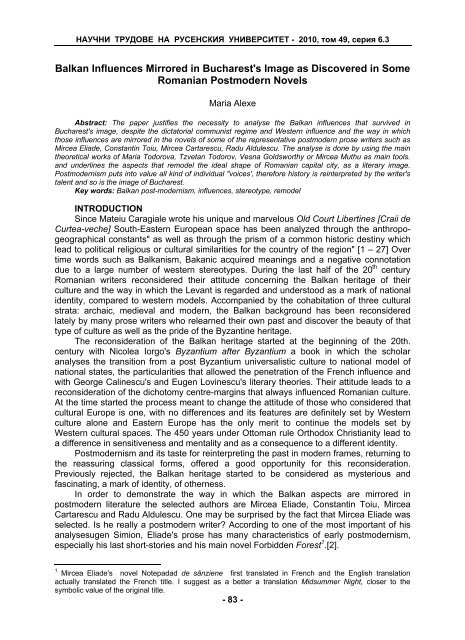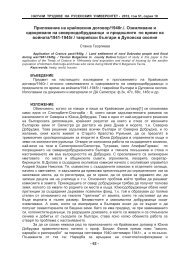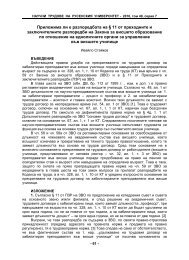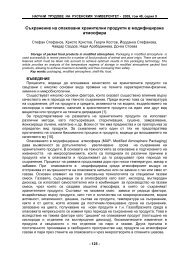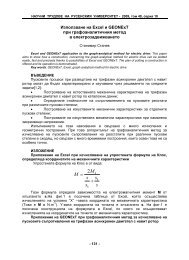Balkan Influences Mirrored in Bucharest's Image as Discovered in ...
Balkan Influences Mirrored in Bucharest's Image as Discovered in ...
Balkan Influences Mirrored in Bucharest's Image as Discovered in ...
You also want an ePaper? Increase the reach of your titles
YUMPU automatically turns print PDFs into web optimized ePapers that Google loves.
НАУЧНИ ТРУДОВЕ НА РУСЕНСКИЯ УНИВЕРСИТЕТ - 2010, том 49, серия 6.3<br />
<strong>Balkan</strong> <strong>Influences</strong> <strong>Mirrored</strong> <strong>in</strong> <strong>Bucharest's</strong> <strong>Image</strong> <strong>as</strong> <strong>Discovered</strong> <strong>in</strong> Some<br />
Romanian Postmodern Novels<br />
Maria Alexe<br />
Abstract: The paper justifies the necessity to analyse the <strong>Balkan</strong> <strong>in</strong>fluences that survived <strong>in</strong><br />
<strong>Bucharest's</strong> image, despite the dictatorial communist regime and Western <strong>in</strong>fluence and the way <strong>in</strong> which<br />
those <strong>in</strong>fluences are mirrored <strong>in</strong> the novels of some of the representative postmodern prose writers such <strong>as</strong><br />
Mircea Eliade, Constant<strong>in</strong> Toiu, Mircea Cartarescu, Radu Aldulescu. The analyse is done by us<strong>in</strong>g the ma<strong>in</strong><br />
theoretical works of Maria Todorova, Tzvetan Todorov, Vesna Goldsworthy or Mircea Muthu <strong>as</strong> ma<strong>in</strong> tools.<br />
and underl<strong>in</strong>es the <strong>as</strong>pects that remodel the ideal shape of Romanian capital city, <strong>as</strong> a literary image.<br />
Postmodernism puts <strong>in</strong>to value all k<strong>in</strong>d of <strong>in</strong>dividual "voices', therefore history is re<strong>in</strong>terpreted by the writer's<br />
talent and so is the image of Bucharest.<br />
Key words: <strong>Balkan</strong> post-modernism, <strong>in</strong>fluences, stereotype, remodel<br />
INTRODUCTION<br />
S<strong>in</strong>ce Mateiu Caragiale wrote his unique and marvelous Old Court Libert<strong>in</strong>es [Craii de<br />
Curtea-veche] South-E<strong>as</strong>tern European space h<strong>as</strong> been analyzed through the anthropogeographical<br />
constants" <strong>as</strong> well <strong>as</strong> through the prism of a common historic dest<strong>in</strong>y which<br />
lead to political religious or cultural similarities for the country of the region" [1 – 27] Over<br />
time words such <strong>as</strong> <strong>Balkan</strong>ism, Bakanic acquired mean<strong>in</strong>gs and a negative connotation<br />
due to a large number of western stereotypes. Dur<strong>in</strong>g the l<strong>as</strong>t half of the 20 th century<br />
Romanian writers reconsidered their attitude concern<strong>in</strong>g the <strong>Balkan</strong> heritage of their<br />
culture and the way <strong>in</strong> which the Levant is regarded and understood <strong>as</strong> a mark of national<br />
identity, compared to western models. Accompanied by the cohabitation of three cultural<br />
strata: archaic, medieval and modern, the <strong>Balkan</strong> background h<strong>as</strong> been reconsidered<br />
lately by many prose writers who relearned their own p<strong>as</strong>t and discover the beauty of that<br />
type of culture <strong>as</strong> well <strong>as</strong> the pride of the Byzant<strong>in</strong>e heritage.<br />
The reconsideration of the <strong>Balkan</strong> heritage started at the beg<strong>in</strong>n<strong>in</strong>g of the 20th.<br />
century with Nicolea Iorgo's Byzantium after Byzantium a book <strong>in</strong> which the scholar<br />
analyses the transition from a post Byzantium universalistic culture to national model of<br />
national states, the particularities that allowed the penetration of the French <strong>in</strong>fluence and<br />
with George Cal<strong>in</strong>escu's and Eugen Lov<strong>in</strong>escu's literary theories. Their attitude leads to a<br />
reconsideration of the dichotomy centre-marg<strong>in</strong>s that always <strong>in</strong>fluenced Romanian culture.<br />
At the time started the process meant to change the attitude of those who considered that<br />
cultural Europe is one, with no differences and its features are def<strong>in</strong>itely set by Western<br />
culture alone and E<strong>as</strong>tern Europe h<strong>as</strong> the only merit to cont<strong>in</strong>ue the models set by<br />
Western cultural spaces. The 450 years under Ottoman rule Orthodox Christianity lead to<br />
a difference <strong>in</strong> sensitiveness and mentality and <strong>as</strong> a consequence to a different identity.<br />
Postmodernism and its t<strong>as</strong>te for re<strong>in</strong>terpret<strong>in</strong>g the p<strong>as</strong>t <strong>in</strong> modern frames, return<strong>in</strong>g to<br />
the re<strong>as</strong>sur<strong>in</strong>g cl<strong>as</strong>sical forms, offered a good opportunity for this reconsideration.<br />
Previously rejected, the <strong>Balkan</strong> heritage started to be considered <strong>as</strong> mysterious and<br />
f<strong>as</strong>c<strong>in</strong>at<strong>in</strong>g, a mark of identity, of otherness.<br />
In order to demonstrate the way <strong>in</strong> which the <strong>Balkan</strong> <strong>as</strong>pects are mirrored <strong>in</strong><br />
postmodern literature the selected authors are Mircea Eliade, Constant<strong>in</strong> Toiu, Mircea<br />
Cartarescu and Radu Aldulescu. One may be surprised by the fact that Mircea Eliade w<strong>as</strong><br />
selected. Is he really a postmodern writer? Accord<strong>in</strong>g to one of the most important of his<br />
analysesugen Simion, Eliade's prose h<strong>as</strong> many characteristics of early postmodernism,<br />
especially his l<strong>as</strong>t short-stories and his ma<strong>in</strong> novel Forbidden Forest 1 .[2].<br />
1<br />
Mircea Eliade's novel Notepadad de sânziene first translated <strong>in</strong> French and the English translation<br />
actually translated the French title. I suggest <strong>as</strong> a better a translation Midsummer Night, closer to the<br />
symbolic value of the orig<strong>in</strong>al title.<br />
- 83 -
НАУЧНИ ТРУДОВЕ НА РУСЕНСКИЯ УНИВЕРСИТЕТ - 2010, том 49, серия 6.3<br />
Even if most of the quoted writers use real details to recreate Bucharest <strong>Balkan</strong><br />
image, what one reads is not a re-creation of deconstructed image of a real town but a<br />
rather poetical image of a place ruled by fant<strong>as</strong>y, legends and myth, brought to life by the<br />
author's sensitiveness and nostalgia. What Eliade described, the city <strong>in</strong> which Toiu's<br />
characters or Mircea Cartarescu are walk<strong>in</strong>g is a projection of the writer's imag<strong>in</strong>ation,<br />
accord<strong>in</strong>g his knowledge about the 17th and the 18th century period.<br />
BUCHAREST – AS A MAIN TOPIC<br />
The process of ruralisation that affected the whole <strong>Balkan</strong> world, the decl<strong>in</strong>e of some<br />
old cities <strong>as</strong> Targoviste (old capital of one of the Romanian medieval states) h<strong>as</strong> turned<br />
Bucharest <strong>in</strong>to the s<strong>in</strong>gle city of the region, the cultural Christian centre of the <strong>Balkan</strong> world<br />
<strong>in</strong> the 18 th century and a large city <strong>in</strong> the com<strong>in</strong>g time. Consequently the city h<strong>as</strong> become<br />
the center of Romanian culture and that is probably the re<strong>as</strong>on why the plot of most of the<br />
outstand<strong>in</strong>g novels of the postmodern period of Romanian literature are set <strong>in</strong> Bucharest.<br />
The city h<strong>as</strong> acquired quite a f<strong>as</strong>c<strong>in</strong>at<strong>in</strong>g cosmopolitan character, gradually develop<strong>in</strong>g<br />
from a small Oriental trade town <strong>in</strong>to a large city where the old Oriental and Byzant<strong>in</strong>e<br />
marks are covers by elements of French architecture <strong>in</strong> the 19 th century and modern<br />
globalization build<strong>in</strong>gs <strong>in</strong> the 20 th century. The structured oral traditions of rural essence<br />
characteriz<strong>in</strong>g with the exception of Greek culture, all other South – E<strong>as</strong>tern cultures,<br />
resistant and conservative [3] is shared by the city <strong>as</strong> well. Lately Chis<strong>in</strong>au, the capital city<br />
of the Moldavian republic seems to turn <strong>in</strong>to a second ma<strong>in</strong> urban topic, but Bucharest is<br />
still considered to be the ma<strong>in</strong> referential po<strong>in</strong>t<br />
In the second half of the 19 th century the city <strong>as</strong> well <strong>as</strong> the whole Romanian society<br />
suffered a process of structural modernization which covered the <strong>Balkan</strong> traces, replaced<br />
legends and mythical visions by realistic descriptions. In the late 20 th century, dur<strong>in</strong>g the<br />
communist period, human relationship <strong>as</strong> well <strong>as</strong> urban structures were ru<strong>in</strong>ed, the<br />
dichotomy centre marg<strong>in</strong>s becom<strong>in</strong>g deeper. Bucharest <strong>as</strong> the whole country w<strong>as</strong><br />
embedded by a dark and sad atmosphere. Beyond the facts determ<strong>in</strong>ed by political and<br />
economic factors, the city h<strong>as</strong> been transformed by its cultural roots, which <strong>in</strong>cludes<br />
<strong>Balkan</strong> identity. In the analyzed work, Bucharest is not just a topic is more then that, it is<br />
what modern critics name a chronotop 2 .<br />
Hated or loved, criticized or praised Bucharest is the cradle of some writers’<br />
<strong>in</strong>spiration. Mircea Cartarescu, who often claimed his <strong>Balkan</strong> orig<strong>in</strong> 3 writes about his city<br />
an essay which sound like a poem "Joyce h<strong>as</strong> Dubl<strong>in</strong>, Borges, Buenos Aires, Durell<br />
Alexandria, but good Lord what have you give me? None of those mythical cities were<br />
given to me" [4 – 85]. The answer to that rhetoric question is quite clear. God gave him<br />
Bucharest, which is neither <strong>as</strong> exotic <strong>as</strong> Alexandria or Buenos Aires, nor <strong>as</strong> picturesque <strong>as</strong><br />
Dubl<strong>in</strong>, but it is his city, hav<strong>in</strong>g his unique charm and magic atmosphere. As a poet he w<strong>as</strong><br />
f<strong>as</strong>c<strong>in</strong>ated by the "beautiful Levant" which gave the name of one of his outstand<strong>in</strong>g<br />
volumes.<br />
MIRCEA ELIADE'S VISION<br />
As he, himself confesses <strong>in</strong> his Journal, Mircea Eliade used his childhood<br />
neigbourhood <strong>as</strong> a ma<strong>in</strong> topic for the short stories written <strong>in</strong> his exile. A precise number of<br />
old streets around the Mantule<strong>as</strong>a 4 street each one with a strange legend go<strong>in</strong>g back to<br />
the 18 th century. In the same work he writes about his deep attachment to his native town 5 .<br />
"Sett<strong>in</strong>g <strong>in</strong> Paris and publish<strong>in</strong>g my books <strong>in</strong> French that did not make me feel that I had<br />
2<br />
The term <strong>in</strong>dicates the fact that the suggestion is complex <strong>in</strong>clud<strong>in</strong>g time and place.<br />
3<br />
Many times and <strong>in</strong> many essays, novels or short stories Cartarescu tells the story of his mother's family<br />
which cross the Danube, due to religious problems and had to come from the <strong>Balkan</strong>s to Romania.<br />
4<br />
Mantule<strong>as</strong>a is the archaic fem<strong>in</strong><strong>in</strong>e of a family name Manta, mean<strong>in</strong>g Manta's wife, suggest the fact that<br />
this is a place connect to the p<strong>as</strong>t.<br />
5<br />
The translation of this fragment and that of other quotations are done by the author of the article<br />
- 84 -
НАУЧНИ ТРУДОВЕ НА РУСЕНСКИЯ УНИВЕРСИТЕТ - 2010, том 49, серия 6.3<br />
lost contact with Romanian culture" [5 – 247] and goes on writ<strong>in</strong>g about the fact that he<br />
can "see" his city, remember the atmosphere, people and places, even if <strong>in</strong> exile. The<br />
reader can reconstruct the image of the city due to many realistic elements, for example<br />
the streets which have real names, some of them be<strong>in</strong>g the same today, the chestnuts<br />
shadow, the sound of the trams <strong>in</strong> early summer morn<strong>in</strong>g. It is obvious that for Eliade the<br />
magic Oriental charm of Bucharest is revealed by hot summer days.<br />
At the same time Eliade's short stories depicted a world <strong>in</strong> which the reader faces a<br />
dichotomy present versus p<strong>as</strong>t, actually fant<strong>as</strong>tic versus real. In The Old Man and the<br />
Officer 6 <strong>as</strong> well <strong>as</strong> In Dyonissos Courtyard complicated stories <strong>in</strong>terrupt the ma<strong>in</strong> subject<br />
<strong>as</strong> <strong>in</strong> Oriental fairy tales. The reader learns about the beautiful Arghira, talented, theatre<br />
lover, but unfortunately almost bl<strong>in</strong>d. She is magically saved by a good witch who is the<br />
ancestor of Mantule<strong>as</strong>a, the lady who gave the street name. Only some of the characters,<br />
those with magic power themselves are aware of the way <strong>in</strong> which present and p<strong>as</strong>t, real<br />
and magic m<strong>in</strong>gle <strong>in</strong> special places, caves or old gardens [6]. One is the old man, former<br />
grammar school teacher who knows a lot of those stories, not only that of Arghira, but also<br />
that of the rabbi's child that one day disappeared <strong>in</strong> a cave of an old house on Mosilor<br />
Road (real name of a Bucharest ma<strong>in</strong> road, realistic detail which makes the story more<br />
<strong>in</strong>terest<strong>in</strong>g), or that of Oana a giant girl, whose family comes from the <strong>Balkan</strong>s, south of<br />
the Danube.<br />
Eliade tells strange facts which happened before the First World War, facts<br />
connected with present day, but actually their roots go deeper <strong>in</strong>to the p<strong>as</strong>t. The luxurious<br />
structure of the story, typical for the <strong>Balkan</strong>s, hides their magic mean<strong>in</strong>g to those who are<br />
not supposed to understand it. The old trees on Bucharest’s narrow streets have the same<br />
mean<strong>in</strong>g at the image level. The old teacher is a "translator" – he re<strong>in</strong>terprets the magic<br />
facts for the officer, for whom only the real facts seem important, he does not pay attention<br />
to their significance. In modern age, when the ma<strong>in</strong> stream of the plot takes place, the old<br />
man looks <strong>as</strong> a displaced person. The French and the English name of the short story<br />
underl<strong>in</strong>es the opposition between these characters, when the orig<strong>in</strong>al Romanian title<br />
reveals the importance of the place – Mantule<strong>as</strong>a Street, a symbol of old <strong>Balkan</strong><br />
Bucharest.<br />
WANDERING ON THE OLD COOURT LIBERTINE'S FOOTSTEPS<br />
Like Maria Todorova <strong>in</strong> her famous book The <strong>Balkan</strong>ism and the <strong>Balkan</strong>s [7],<br />
Constant<strong>in</strong> Toiu fights aga<strong>in</strong>st western stereotypes. The city he depicts is charm<strong>in</strong>g. He<br />
agrees with the mystery and the picturesque, but the image offered is that of a friendly city,<br />
gentle, a place where traditions are valued and people are <strong>in</strong>terested <strong>in</strong> the glory of the<br />
p<strong>as</strong>t, not a place of violence and conflicts. The writer’s ma<strong>in</strong> characters of The Gallery with<br />
Wild W<strong>in</strong>e 7 , a young writer and an old antiquarian like to walk around, remak<strong>in</strong>g the way<br />
described by Mateiu Caragiale's heroes. Dur<strong>in</strong>g their walk they arrive <strong>in</strong> the middle of old<br />
Bucharest, near the Old Court, where one of their friend lives: “They were liv<strong>in</strong>g <strong>in</strong> one of<br />
those houses on gabroveni, <strong>in</strong> which you got through a dark and dirty p<strong>as</strong>sage. At the<br />
ground-floor there were shops, merchandise, warehouses, upstairs there were offices" [8 –<br />
268] then they go on to that part of the city, which accord<strong>in</strong>g to the author's op<strong>in</strong>ion turns<br />
Turkish and Oriental. They are on the right shore of Dambovita river, an old area, which<br />
image is opposed to the so called western image of the large avenues.<br />
The image is a post-modern version of the city face, fragments and pieces, describ<strong>in</strong>g<br />
small m<strong>as</strong>terpieces of architecture, churches or just anonymous old houses. The writer<br />
cuts pieces, deconstruct the image and through those fragments the author recreates<br />
another image of the city, not the communist grey one, but a charm<strong>in</strong>g city covered by a<br />
6<br />
Aga<strong>in</strong> the English translation follows the French version Le vieil Homme et l'officier. The Romanian orig<strong>in</strong>al<br />
title is Pe strada Mantule<strong>as</strong>a (On Mantule<strong>as</strong>a Street)<br />
7<br />
The orig<strong>in</strong>al title Galeria cu viţă sălbatică po<strong>in</strong>ts the fact that the ma<strong>in</strong> characters of the novel used to<br />
gather <strong>in</strong> a cout-yard, under the Wild W<strong>in</strong>e.<br />
- 85 -
НАУЧНИ ТРУДОВЕ НА РУСЕНСКИЯ УНИВЕРСИТЕТ - 2010, том 49, серия 6.3<br />
shell. The beauty of this image is almost magic. In Constant<strong>in</strong> Toiu's novels The Gallery<br />
with the Wild W<strong>in</strong>e <strong>as</strong> well <strong>as</strong> <strong>in</strong> Obligado, the ma<strong>in</strong> characters talk a lot about all facts and<br />
events that marked Bucharest and there is always an position between the p<strong>as</strong>t and the<br />
present, where the p<strong>as</strong>t represents an ideal world. The old antiquarian or the architect JT<br />
are witnesses of those p<strong>as</strong>t times and share their experience with their younger friends. it<br />
is recurr<strong>in</strong>g image of a city that no longer exists but can be reconstructed by storytell<strong>in</strong>g.<br />
Almost the same part of the old Bucharest, along the Dambovita w<strong>as</strong> turned by Radu<br />
Aldulescu <strong>in</strong>to the sett<strong>in</strong>g of one of his best novel The Old Lady's Lover 8 . After a longer<br />
communist period the town seems to loose its charm and shows a dirty and decomposed<br />
face. Human drama is revealed by the ugl<strong>in</strong>ess of the old charm<strong>in</strong>g part of Bucharest.<br />
Unlike other writers, Radu Aldulescu does not sympathies with his ma<strong>in</strong> character<br />
who is a projection of all sorts of "bad th<strong>in</strong>gs" which are considered to be marks for the late<br />
communist period. His attitude is due ma<strong>in</strong>ly to the <strong>Balkan</strong> philosophy of "<strong>as</strong> if" which,<br />
despite the dictatorial regime, empowers him with a sense of great <strong>in</strong>ner freedom and the<br />
capacity to resist to all k<strong>in</strong>d of restrictive frames and gives the sense of otherness. This<br />
attitude is reflected on the city description and the city image is the reflection of that type of<br />
mentality.<br />
Radu Adolescent's Bucharest is dirty, is unple<strong>as</strong>ant and terrify<strong>in</strong>g because people<br />
h<strong>as</strong> change it. As a real postmodern chronotop the city mirrors the epoch.<br />
MIRCEA CARTARESCU'S BUCHAREST<br />
As many other famous writers, Mircea Cartarescu seems to be obsessed by his<br />
native town, Bucharest. It is the town he hates and loves at the same time, <strong>in</strong> which he<br />
changed himself from a little boy who walks along dusty streets with his mother <strong>in</strong>to a<br />
student who discovered the large boulevards of the down town and later <strong>in</strong>to the writer he<br />
is today. The dichotomy marg<strong>in</strong>s/centre becomes <strong>in</strong> his c<strong>as</strong>e his own self build<strong>in</strong>g<br />
achievement.<br />
In fact the image of the town becomes the center of the writer universe, a large<br />
spiritual centre spread<strong>in</strong>g from the house of his early childhood, an imag<strong>in</strong>ary and real<br />
house at the same time, from the <strong>Balkan</strong> and picturesque town to the contemporary city.<br />
He presents a postmodern vision of city fragments which <strong>in</strong>terfere with his creative<br />
process. As a postmodern writer Cartarescu uses the image of the town depicted by other<br />
writers before him, such <strong>as</strong> Mateiu Caragiale, Mircea Eliade or Constant<strong>in</strong> Toiu, but<br />
re<strong>in</strong>terprets them and the town seems to be a huge butterfly, ready to fly by the novelist<br />
imag<strong>in</strong>ary w<strong>in</strong>gs.[9]. He faces the <strong>Balkan</strong> image of his native town without any complex,<br />
aware of the fact that this is the centre of a magic geography.<br />
When describ<strong>in</strong>g Bucharest, Mircea Cartarescu pay attention to all k<strong>in</strong>d of details, old<br />
fences, savage gardens, the way <strong>in</strong> which flowers smell, all k<strong>in</strong>d of an important th<strong>in</strong>gs,<br />
which make the city look so different. His keen eye observes all sort of <strong>as</strong>pects belong<strong>in</strong>g<br />
to the Oriental face or to the western one, details that mangle <strong>in</strong> order to achieve the<br />
unique charm of a city which is considered to be "his Bucharest" 9 , the city he knows so<br />
well, loves and hates at the same time. In his description one may f<strong>in</strong>d a city like a mosaic<br />
where ugly communist block of flats stay close to a beautiful old house with Oriental<br />
architecture details and large modern avenues are marked by bookshops, libraries or<br />
exhibitions, by place where you can meet a friend or read a book. The author walks start <strong>in</strong><br />
reality and end <strong>in</strong> a mythological p<strong>as</strong>t, often belong<strong>in</strong>g to a long - time lost archaic period,<br />
<strong>in</strong> search of the <strong>as</strong>sumed <strong>Balkan</strong> roots or of his personal and artistic identity. The image of<br />
a door or an open w<strong>in</strong>dow marks the p<strong>as</strong>sage.<br />
8<br />
The Romanian title Amantul Colivaresei, suggests the promiscuity of the l<strong>as</strong>t period of the communist era.<br />
9<br />
In the volume Always young and wrapped <strong>in</strong> pixels (Pururi tânăr înfăşurat în pixeli), the title of one of the<br />
essays is My Bucharest. (Pururi tânăr înfăşurat în pixeli, Humanit<strong>as</strong>, Bucuresti 2003, pag 14)<br />
- 86 -
НАУЧНИ ТРУДОВЕ НА РУСЕНСКИЯ УНИВЕРСИТЕТ - 2010, том 49, серия 6.3<br />
Accord<strong>in</strong>g to John Lye, Postmodernism can be def<strong>in</strong>ed a writ<strong>in</strong>g of "reflexive" or meta<br />
fiction, fiction which is <strong>in</strong> the first <strong>in</strong>stance aware of itself <strong>as</strong> fiction and which may<br />
dramatize the false or constructed nature of fiction, on the one hand, or the <strong>in</strong>evitable<br />
fictionality of all experience, on the other" [10, p. 4], a deep reflexive attitude expla<strong>in</strong>s<br />
Cartarescu's vision. His image is subjective, but the reader is <strong>in</strong>vited share the writer<br />
experience and to understand or to reject that vision. Actually this attitude makes<br />
Cartarescu's books so post modern and so rich <strong>in</strong> symbols.<br />
CONCLUSIONS<br />
The author's <strong>in</strong>tention to look for a <strong>Balkan</strong> <strong>in</strong>fluence and Byzant<strong>in</strong>e roots <strong>in</strong> the work<br />
of some of the most important Romanian postmodern prose writers is challeng<strong>in</strong>g but<br />
reward<strong>in</strong>g t<strong>as</strong>k, because there is quite difficult to use the tools of scientific research and<br />
accuracy on a territory belong<strong>in</strong>g to fant<strong>as</strong>y. The analysis tried to demonstrate that <strong>in</strong><br />
some novels of some Romanian postmodern writers the reader may discover an other<br />
face of Bucharest, a old <strong>Balkan</strong> friendly environment, hidden under the modern global face<br />
of the contemporary city. This is a image that the sensitivity of a writer can reveal to his<br />
readers.<br />
At the beg<strong>in</strong>n<strong>in</strong>g of a new millennium Romanian culture is still search<strong>in</strong>g for its<br />
identity between the <strong>Balkan</strong> heritage, the Western <strong>in</strong>fluence of the 19 th century and<br />
contemporary globalisation. How much do we owe to the Oriental p<strong>as</strong>t and how much to<br />
our Lat<strong>in</strong> orig<strong>in</strong>? In contemporary times, geographical boundaries are no longer<br />
considered important – but the imag<strong>in</strong>ary boundary between E<strong>as</strong>t and West is still a<br />
challenge and that is where the magic of art and literature can help to overcome it.<br />
REFERENCES<br />
[1] Albu, M. “Carm<strong>in</strong>a Balacnica and the Intercultural Dialogue”. In Carmaian<br />
Balcanica, Review of South-E<strong>as</strong>t European Spirituality and Culture, Year II, No. 2(3),<br />
November, 2009.<br />
[2] Simion, E., Mircea Eliade. Nodurile si semnele prozei, Editura Junimea Iaşi, 2006.<br />
[3] Muthu, M., “Mentality, Identity and South-E<strong>as</strong>t European Otherness”. In Carm<strong>in</strong>a<br />
Balcanica, anul I, No. 1, 2008, November 2008.<br />
[4] Cărtărescu, M., Pururi tânăr înfăşurat în pixeli,Editura Humanit<strong>as</strong>, Bucureşti, 2003.<br />
[5] Eliade, Mircea, Memorii, editura Humanit<strong>as</strong>, Bucuresti, 1992, Vol II<br />
[6] Alexe, M. “Romanian Identity <strong>in</strong> Eliade's Novels and Short Stories”. In<br />
Proceed<strong>in</strong>gs of the Seventh Cultural Studies Symposium, Ege University Izmir, May 2002,<br />
Selves at Home, Selves <strong>in</strong> Exile, published by department of American Culture and<br />
Literature and Department of English Language and Literature, Ege University, American<br />
Association of Turkey (ASAT).<br />
[7] Todorova, M. Balcanii şi balcanismul, Editura Humanit<strong>as</strong>, Bucureşti, 2000.<br />
[8]Toiu, C., Galeria cu viţă sălbatică, Litera Internaţional Publish<strong>in</strong>g House, Bucureşti,<br />
2002.<br />
[9] Cărtărescu, M., Orbitor; Aripa stânga, Editura Humanit<strong>as</strong>, Bucureşti, 2002.<br />
[10] Lye, J. “Some attributes of Post-Modernist literature”, Internet Sources, Copyright<br />
1997, 1998, 1999, l<strong>as</strong>t updated December, 4, 2002<br />
ABOUT THE AUTHOR<br />
Lecturer Maria Alexe, PhD, National University of Arts Bucharest, Phone: +359 82<br />
447 212, Е-mail: marialexe2010@gmail.com<br />
The paper is reviewed.<br />
- 87 -


